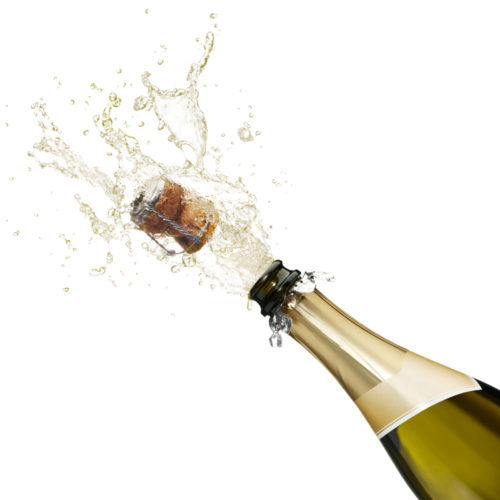Around the holidays, many people love pulling out the Champagne and toasting to just about anything! There are also quite a few drinkers who don’t know a thing about the bubbly but who truly enjoy sipping the liquid tickler. According to the famed consumer spending watchdog company, Nielsen, Americans are increasing their consumption of the bubbly and not just at weddings, New Year’s eve parties, or anniversaries. So if you plan on popping bottles this New Year’s, you might want to learn a few interesting tidbits about the bubbly that you didn’t know about; here are ten:
- In order for Champagne to be given its label, it actually has to come from the Champagne region in France that is known for its cold, wet climate. The weather affects the acidity and taste of the three commonly used types of grapes (pinot noir, pinot meunier, and chardonnay) to make the Champagne.
- According to a scientific calculation, there are around 49 billion bubbles in a bottle of Champagne, a little under 1/5 the number of stars in the Milky Way.
- A Champagne cork travels at the speed of about 25 mph when it is shaken then popped open. Believe it or not, champagne corks kill almost 24 people each year. The improperly aimed popping of Champagne corks is also one of the most common causes for holiday-related eye injuries, according to the American Academy of Ophthalmology.
- Champagne flutes are cute but impractical. If you really want to enjoy the full-bodied experience of the beverage, you should drink it out of a wine glass in order to savor its complexity which translates into both smell and taste, as the two are connected.
- Don’t buy Champagne off a shelf! Ask for a bottle from the retailer’s back room instead. Champagne tends to lose its quality when exposed to light, so getting it right out of a shipping box is the best way to ensure that it is up to par.
- Don’t store Champagne in the fridge as doing so will dry out and shrink the cork resulting in not only the escape of carbonation but the penetration of surrounding food odors and flavors. If you do decide to chill the bubbly, the best way to do so is to fill an ice bucket with ice and one-third water and allow your bottle to cool for 15-20 minutes
- When pouring Champagne, only fill your glass to about one-third of the way full. Over-pouring the beverage will only result in warm Champagne.
- When drinking Champagne hold the glass by the stem and NOT by the bowl because you’ll only warm it up.
- Once you open a bottle, make sure to use a stopper if you don’t finish its contents. A stopper will keep Champagne bubbles fresh for about a day.
- The best foods to pair with Champagne are salty, oily and fatty selections because they bring out the wine’s fruitiness and freshness.
- The most expensive bottle of Champagne costs $2.07 million dollars. This bottle literally has a diamond ingrained in the design on the outside.
- Champagne is just a sparkling wine. Yeast and sugar is added to wine for a second fermentation which creates the bubbles that make the Champagne.
Here are a few really wonderful $60 and under brut Champagnes that will absolutely NOT disappoint:
Champagne Bollinger Special Cuvee: A brut; varietal: Chardonnay, Pinot noir, Pinot Meunier; $60, wine.com
Champagne Charles Heidsieck Brut Reserve: A brut; varietal: Chardonnay, Pinot noir, Pinot Meunier; $50, sokolin.com
Champagne Pol Roger Brut: A brut; varietal: Chardonnay, Pinot noir, Pinot Meunier; $50, wine.com
Champagne Gosset Brut Excellence: A brut; varietal: Chardonnay, Pinot noir, Pinot Meunier; $40, wine.com
Champagne Moët & Chandon Imperial Brut: A brut; varietal: Chardonnay, Pinot noir, Pinot Meunier; $40, totalwine.com
Champagne Nicolas Feuillatte Reserve Exclusive Brut: A brut; varietal: Chardonnay, Pinot noir, Pinot Meunier; $38, wine.com
Cheers!











